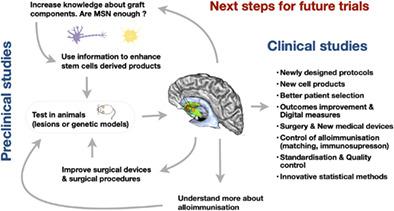当前位置:
X-MOL 学术
›
STEM CELLS
›
论文详情
Our official English website, www.x-mol.net, welcomes your feedback! (Note: you will need to create a separate account there.)
Cell therapy in Huntington's disease: Taking stock of past studies to move the field forward
STEM CELLS ( IF 5.2 ) Pub Date : 2020-11-11 , DOI: 10.1002/stem.3300 Anne-Catherine Bachoud-Lévi 1, 2, 3, 4, 5 , Renaud Massart 1, 2, 3, 4 , Anne Rosser 6, 7, 8, 9
STEM CELLS ( IF 5.2 ) Pub Date : 2020-11-11 , DOI: 10.1002/stem.3300 Anne-Catherine Bachoud-Lévi 1, 2, 3, 4, 5 , Renaud Massart 1, 2, 3, 4 , Anne Rosser 6, 7, 8, 9
Affiliation

|
Huntington's disease (HD) is a rare inherited neurodegenerative disease that manifests mostly in adulthood with progressive cognitive, behavioral, and motor dysfunction. Neuronal loss occurs predominantly in the striatum but also extends to other brain regions, notably the cortex. Most patients die around 20 years after motor onset, although there is variability in the rate of progression and some phenotypic heterogeneity. The most advanced experimental therapies currently are huntingtin‐lowering strategies, some of which are in stage 3 clinical trials. However, even if these approaches are successful, it is unlikely that they will be applicable to all patients or will completely halt continued loss of neural cells in all cases. On the other hand, cellular therapies have the potential to restore atrophied tissues and may therefore provide an important complementary therapeutic avenue. Pilot studies of fetal cell grafts in the 2000s reported the most dramatic clinical improvements yet achieved for this disease, but subsequent studies have so far failed to identify methodology to reliably reproduce these results. Moving forward, a major challenge will be to generate suitable donor cells from (nonfetal) cell sources, but in parallel there are a host of procedural and trial design issues that will be important for improving reliability of transplants and so urgently need attention. Here, we consider findings that have emerged from clinical transplant studies in HD to date, in particular new findings emerging from the recent multicenter intracerebral transplant HD study, and consider how these data may be used to inform future cell therapy trials.
中文翻译:

亨廷顿病的细胞疗法:回顾过去的研究以推动该领域的发展
亨廷顿舞蹈病 (HD) 是一种罕见的遗传性神经退行性疾病,主要表现在成年期,伴有进行性认知、行为和运动功能障碍。神经元丢失主要发生在纹状体中,但也延伸到其他大脑区域,尤其是皮质。大多数患者在运动发作后约 20 年死亡,尽管进展速度和一些表型异质性存在差异。目前最先进的实验疗法是降低亨廷顿蛋白的策略,其中一些处于 3 期临床试验阶段。然而,即使这些方法成功,它们也不太可能适用于所有患者或完全阻止所有情况下神经细胞的持续丢失。另一方面,细胞疗法具有恢复萎缩组织的潜力,因此可能提供重要的补充治疗途径。2000 年代对胎儿细胞移植物的初步研究报告称,该疾病取得了迄今为止最显着的临床改善,但随后的研究迄今未能确定可靠地重现这些结果的方法。展望未来,一个主要挑战将是从(非胎儿)细胞来源产生合适的供体细胞,但同时存在许多程序和试验设计问题,这些问题对于提高移植的可靠性很重要,因此迫切需要引起注意。在这里,我们考虑了迄今为止 HD 临床移植研究中出现的发现,特别是最近多中心脑内移植 HD 研究中出现的新发现,
更新日期:2020-11-11
中文翻译:

亨廷顿病的细胞疗法:回顾过去的研究以推动该领域的发展
亨廷顿舞蹈病 (HD) 是一种罕见的遗传性神经退行性疾病,主要表现在成年期,伴有进行性认知、行为和运动功能障碍。神经元丢失主要发生在纹状体中,但也延伸到其他大脑区域,尤其是皮质。大多数患者在运动发作后约 20 年死亡,尽管进展速度和一些表型异质性存在差异。目前最先进的实验疗法是降低亨廷顿蛋白的策略,其中一些处于 3 期临床试验阶段。然而,即使这些方法成功,它们也不太可能适用于所有患者或完全阻止所有情况下神经细胞的持续丢失。另一方面,细胞疗法具有恢复萎缩组织的潜力,因此可能提供重要的补充治疗途径。2000 年代对胎儿细胞移植物的初步研究报告称,该疾病取得了迄今为止最显着的临床改善,但随后的研究迄今未能确定可靠地重现这些结果的方法。展望未来,一个主要挑战将是从(非胎儿)细胞来源产生合适的供体细胞,但同时存在许多程序和试验设计问题,这些问题对于提高移植的可靠性很重要,因此迫切需要引起注意。在这里,我们考虑了迄今为止 HD 临床移植研究中出现的发现,特别是最近多中心脑内移植 HD 研究中出现的新发现,



























 京公网安备 11010802027423号
京公网安备 11010802027423号